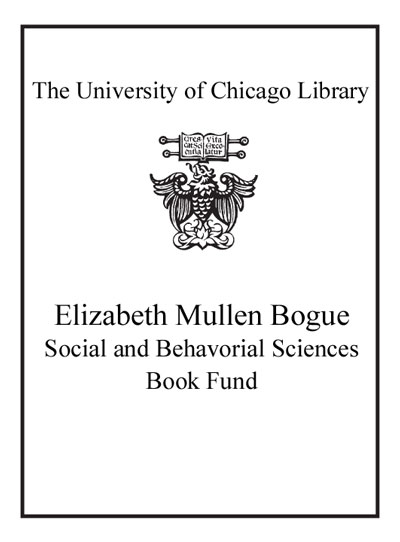Understanding large temporal networks and spatial networks : exploration, pattern searching, visualization and network evolution /
Saved in:
| Author / Creator: | Batagelj, Vladimir, 1948- author. |
|---|---|
| Imprint: | Chichester, West Sussex : John Wiley & Sons, 2014. |
| Description: | xiv, 450 pages ; 25 cm. |
| Language: | English |
| Series: | Wiley series in computational and quantitative social science Wiley series in computational and quantitative social science. |
| Subject: | |
| Format: | Print Book |
| URL for this record: | http://pi.lib.uchicago.edu/1001/cat/bib/10103205 |
| Summary: | This book explores social mechanisms that drive network change and link them to computationally sound models of changing structure to detect patterns. This text identifies the social processes generating these networks and how networks have evolved.<br> <p> Reviews: <br> "this book is easy to read and entertaining, and much can be learned from it. Even if you know just about<br> everything about large-scale and temporal networks, the book is a worthwhile read; you will learn a lot about SNA literature, patents, the US Supreme Court, and European soccer." (Social Networks)</p> <p>"a clear and accessible textbook, balancing symbolic maths, code, and visual explanations. The authors' enthusiasm for the subject matter makes it enjoyable to read" (JASSS)</p> |
|---|---|
| Item Description: | Machine generated contents note: Dedication Preface 1 Temporal and spatial networks 1.1 Modern social network analysis 1.2 Network sizes 1.3 Substantive concerns 1.4 Computational methods 1.5 Data for large temporal networks 1.6 Induction and deduction 2 Foundations of methods for large networks 2.1 Networks 2.2 Types of networks 2.3 Large networks 2.4 Strategies for analyzing large networks 2.5 Statistical network measures 2.6 Subnetworks 2.7 Connectivity properties of networks 2.8 Triangular and short cycle connectivities 2.9 Islands 2.10 Cores and generalized cores 2.11 Important vertices in networks 2.12 Transition to methods for large networks 3 Methods for large networks 3.1 Acyclic networks 3.2 SPC weights in acyclic networks 3.3 Probabilistic flow in acyclic network 3.4 Nonacyclic citation networks 3.5 Two-mode networks from data tables 3.6 Bibliographic networks 3.7 Weights 3.8 Pathfinder 3.9 Clustering, blockmodeling and community detection 3.10 Clustering symbolic data 3.11 Approaches to temporal networks 3.12 Levels of analysis 3.13 Transition to substantive part 4 Scientific citation and other bibliographic networks 4.1 The centrality citation network 4.2 Preliminary data analyses 4.3 Transforming a citation network into an acyclic network 4.4 The most important works 4.5 SPC weights 4.6 Line cuts 4.7 Line islands 4.8 Other relevant subnetworks for a bounded network 4.9 Collaboration networks 4.10 A brief look at the SNA literature SN5 networks 4.11 On the centrality and SNA collaboration networks 5 Citation patterns in a United States patent data 5.1 Patents 5.2 Supreme Court decisions regarding patents 5.3 The 1976-2006 patent data 5.4 Structural Variables through Time 5.5 Some patterns of technological development 5.6 Important Sub Networks 5.7 Citation Patterns 5.8 Comparing citation patterns for two time intervals 5.9 Summary and conclusions 6 The US Supreme Court Citation Network 6.1 Introduction 6.2 Cocited islands of Supreme Court decisions 6.3 A Native American Line Island 6.4 A 'Perceived Threats to Social Order' line island 6.5 Other perceived threats 6.6 The Dred Scott Decision 6.7 Further reflections on the Supreme Court citation network 7 Football as the world's game 7.1 A brief historical overview 7.2 Football clubs 7.3 Football players 7.4 Football in England 7.5 Player migrations 7.6 Institutional arrangements and the organization of football 7.7 Court rulings 7.8 Specific factors impacting football migration 7.9 Some arguments and propositions 7.10 Some preliminary results 7.11 Player ages when recruited to the EPL 7.12 A partial summary of results 8 Networks of player movements to the EPL 8.1 Success in the EPL 8.2 The overall presence of other countries in the EPL 8.3 Network flows of footballers between clubs to reach the EPL 8.4 Moves from EPL clubs 8.5 Moves solely within the EPL 8.6 All trails of footballers to the EPL 8.7 Summary and conclusions 9 Mapping Spatial Diversity in the United States of America 9.1 Mapping Nations as Spatial Units of the United States 9.2 Representing networks in space 9.3 Clustering with a relational constraint 9.4 Data for constrained spatial clustering 9.5 Clustering the US counties with a spatial relational constraint 9.6 Summary 10 On studying large networks 10.1 Substance 10.2 Methods, techniques and algorithms 10.3 Network data 10.4 Surprises and issues triggered by them 10.5 Future work 10.6 Two final comments Appendix: Data Documentation A.1 Bibliographic networks A.2 Patent data A.3 Supreme Court data A.4 Football Data A.5 The USA spatial county network References Person index Subject index . |
| Physical Description: | xiv, 450 pages ; 25 cm. |
| Bibliography: | Includes bibliographical references and index. |
| ISBN: | 9780470714522 0470714522 |

